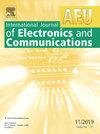Multifunction dielectric resonator antenna featuring omnidirectional switchable patterns
IF 3
3区 计算机科学
Q2 ENGINEERING, ELECTRICAL & ELECTRONIC
Aeu-International Journal of Electronics and Communications
Pub Date : 2025-03-05
DOI:10.1016/j.aeue.2025.155750
引用次数: 0
Abstract
This article presents innovative techniques for designing a multifunctional dielectric resonator antenna (DRA) system capable of omnidirectional switchable polarization and radiation patterns. The system comprises a four-port antenna and two back-to-back rectangular DRAs (RDRAs) mounted on a double-layer circular ground substrate. Each RDRA is excited by two orthogonal pole feeds via stripline for TE1δ1/TEδ11 mode operation, generating a bi-directional pattern. Eight rectangular slots on each ground surface form a defected ground structure (DGS), allowing precise control of ground plane currents and enabling dynamic beamwidth adjustment within the four-port antenna system. Strategic port selection facilitates a transition to reconfigurable omnidirectional radiation, offering linear polarization orientation and beam scanning across the entire sphere. The DGS also minimizes cross-polarization in these omnidirectional patterns. The article explores the underlying physics of beamwidth expansion and cross-polarization reduction. The four-port antenna with DGS achieves a 170° HPBW in the E-plane and 180° in the H-plane, with −16 dB port isolation, while reconfigurable omnidirectional patterns exhibit −25 dB cross-polarization suppression. Simulations using Ansys HFSS and CST Studio, along with prototype fabrication and testing, validate the four-port antenna performance and reconfigurable omnidirectional functionalities. This proposed antenna is suitable for Wi-Fi, 5G, and other modern communication applications.
具有全向可切换模式的多功能介质谐振器天线
本文介绍了一种具有全向可切换极化和辐射方向图的多功能介质谐振器天线(DRA)系统的创新设计技术。该系统包括一个四端口天线和两个背靠背矩形DRAs (RDRAs),安装在双层圆形接地基板上。每个RDRA由两个正交的极源通过带状线激发,用于TE1δ1/TEδ11模式工作,产生双向图样。每个地表面上的八个矩形槽形成一个缺陷地结构(DGS),允许精确控制地平面电流,并在四端口天线系统内实现动态波束宽度调整。策略性的端口选择有助于过渡到可重构的全向辐射,提供线性极化取向和整个球体的波束扫描。DGS还使这些全向模式中的交叉极化最小化。本文探讨了波束宽度扩展和交叉极化减小的基本物理原理。带DGS的四端口天线在e面和h面分别实现了170°和180°的HPBW,端口隔离为- 16 dB,而可重构全向天线的交叉极化抑制为- 25 dB。使用Ansys HFSS和CST Studio进行仿真,以及原型制造和测试,验证了四端口天线的性能和可重构的全向功能。该天线适用于Wi-Fi、5G和其他现代通信应用。
本文章由计算机程序翻译,如有差异,请以英文原文为准。
求助全文
约1分钟内获得全文
求助全文
来源期刊
CiteScore
6.90
自引率
18.80%
发文量
292
审稿时长
4.9 months
期刊介绍:
AEÜ is an international scientific journal which publishes both original works and invited tutorials. The journal''s scope covers all aspects of theory and design of circuits, systems and devices for electronics, signal processing, and communication, including:
signal and system theory, digital signal processing
network theory and circuit design
information theory, communication theory and techniques, modulation, source and channel coding
switching theory and techniques, communication protocols
optical communications
microwave theory and techniques, radar, sonar
antennas, wave propagation
AEÜ publishes full papers and letters with very short turn around time but a high standard review process. Review cycles are typically finished within twelve weeks by application of modern electronic communication facilities.

 求助内容:
求助内容: 应助结果提醒方式:
应助结果提醒方式:


